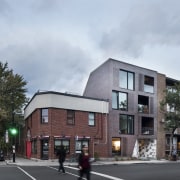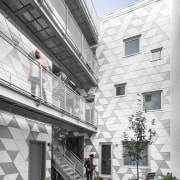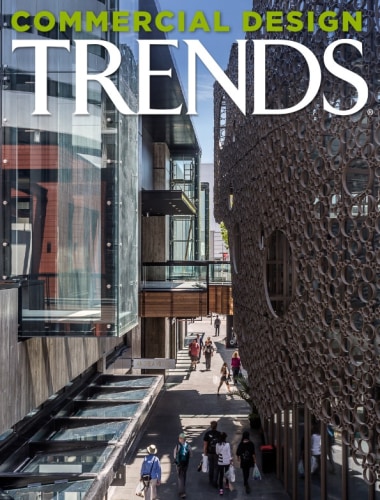Rough brick facade fronts an innovative apartment building with a communal courtyard at its heart
In an historically working class neighbourhood of Montreal known for its residential energy and vibrancy, La Géode apartment building reveals a new approach to urban living

Coming up with a completely new model for residential living in a city can require an intrepid approach from an architect. Often city bylaws will work against him or her, and developers may also be apprehensive as to how readily a fresh design vernacular will appeal to buyers.
Based in Montreal, the ADHOC Architectes team has designed an alternative blueprint for residential living that challenges the tradition for long narrow homes on small lots that's been typical in the city.
For this ground-breaking design, ADHOC cleared a one-level home hogging a rather small 7m x 24m site and replaced it with a five-apartment building that wraps around a private inner courtyard.
Lead architect Jean-Frane§ois St-Onge explains how the name of the complex La Geode is a metaphor for the design.
"Geologically speaking, a geode is a rock with a hollow centre lined with sparkling crystals and here the apartment building is the protective rock, while the courtyard is the secret jewel hidden inside."
La Geode is located on de la Roche, in the neighbourhood of Le Plateau Mont-Royal a traditionally vibrant residential environment with many brick frontages. In response, ADHOC has created La Geode's street-facing facade in brickwork punctuated by windows that loosely approximate to building frontages to left and right.
Set into this classic facade is the opening to an access tunnel lined in triangular metal tiles a fresh material language for a new style of dwelling.

"The tiles' shimmering tones blend with the hues of the sky their sparkling materiality reminiscent of the geode's crystal-studded interior," says St-Onge.
"The headers in the brick layer on the street facade reflect the mineral roughness and protective aspect of the geode."
The main advantages of La Geode for the city of Montreal are the non-disruption of the classic streetscape and the revitalisation of an urban environment that residential occupancy brings.
"For residents, however, the advantages are many ranging from the private inner-courtyard that admits natural light but not street noise, to enjoying maximum internal apartment space that, in a different kind of design, might have been soaked up by circulation corridors," says St-Onge.
And it is the architecture itself that brings these pluses to the people that live there. Seen from above, the site reveals how the central laneway and courtyard divide the building with the original house there had been no throughway to the street behind. The nature of the wrap-around architecture also helps stop sound from penetrating to the internal courtyard. In addition, staircases at the ends of the building and external landings that face into the courtyard avoid the need for internal corridors.
One of the cleverest aspects of the building design facilitated the courtyard's sunny ambience.
"In this area we couldn't build above three levels unless the fourth storey is defined as a mezzanine floor. And for that designation it has to take up only 40% of the building floorplate. In such situations, the vacant part of the floor is stipulated to form a step-back from the street facade, basically to optimise sunlight penetration down to the street.

"Here, however, we persuaded the local council to let us have the step-back on the courtyard-facing sides of the building creating a wider angle of sunlight penetration into the centre.
"In addition, part of this project depended on our ability to create healthy, light-filled apartment interiors including for the ground floor basements. This constraint prompted us to completely rethink the generic basement from a qualitative aspect."
Pavement windows were utilised to channel natural light into the basement rooms. Plus, glass floors were installed between the ground floor and the basement of the ground level apartments, again increasing light penetration.
Green strategies and high energy performance also underpin the innovative project. As a result, La Geode is expected to become the first multi-unit building to achieve LEED v4 certification in Canada.
"Specification of energy-efficient materials was an essential part of the strategy for this building," says St-Onge. "In addition, La Geode's acoustic performance exceeds good practice.
So how well has this new style of medium-density dwelling been received? La Geode's five apartments were quickly taken up and due to vigorous, even invasive, interest from the public, a gated entry has now had to be installed at both ends of the complex.
Credit list
Project
Structural engineer
Landscape architect
Windows
Architect
Mechanical engineer
Facade
Story by: Charles Moxham
Photography by: Adrien Williams
Home kitchen bathroom commercial design
Commercial Design Trends Vol. 33/4C
While the quest for large inner city residential towers continues, there’s a realisation that this style of apartment do...
Read More












